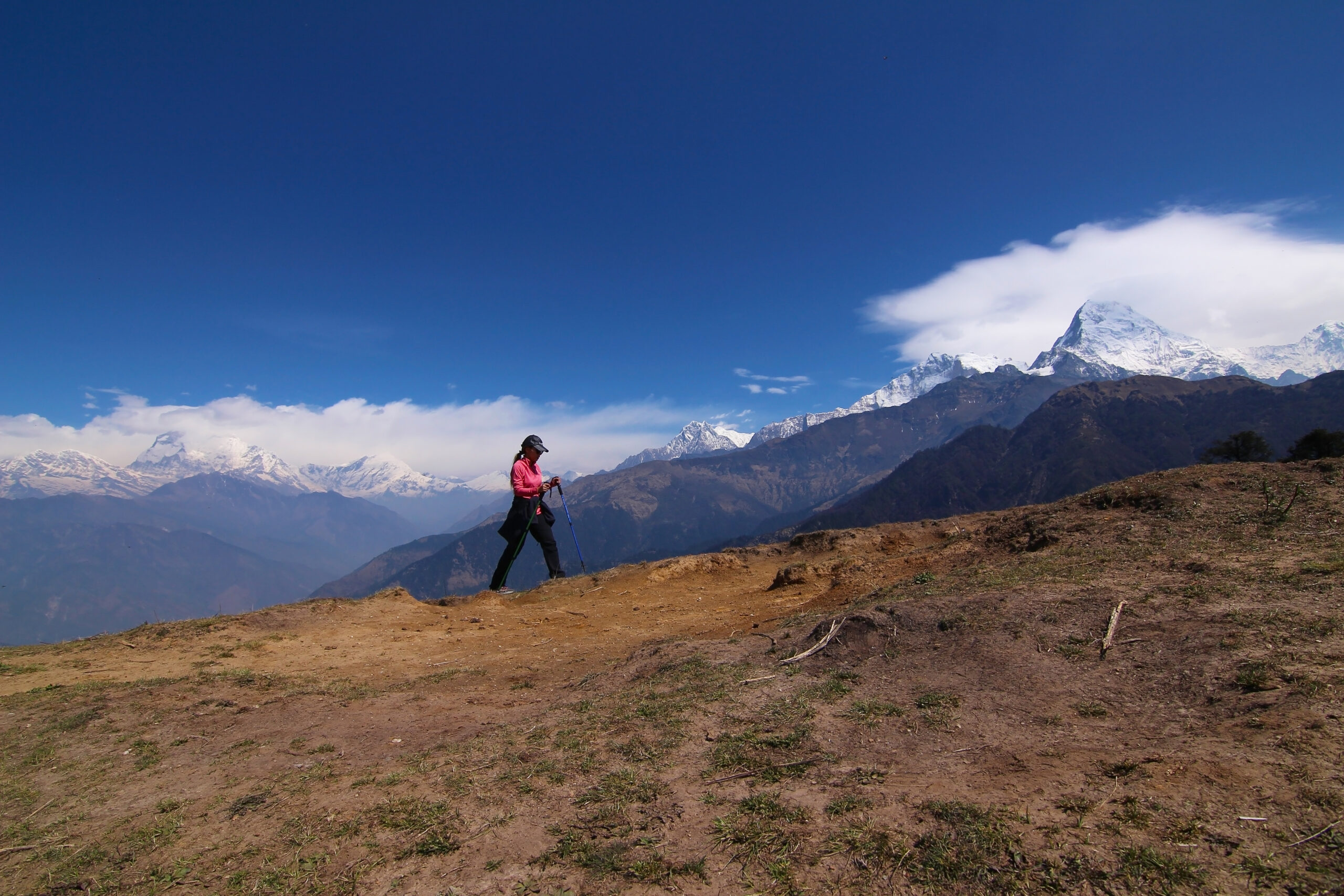
The Poon Hill Trek is one of the most popular short treks in Nepal, offering a perfect blend of breathtaking mountain views, rich local culture, and accessible trails. Located in the heart of the Annapurna region, the Poon Hill Trek is famous for its unforgettable sunrise over the Annapurna and Dhaulagiri ranges, vibrant rhododendron forests, and the warm hospitality of Gurung and Magar villages. Ideal for beginners and experienced hikers, the Poon Hill Trek delivers a rewarding Himalayan experience in just a few days.
Why Choose the Poon Hill Trek?
Stunning Sunrise – Watch the golden sun rise over the Annapurna and Dhaulagiri ranges from Poon Hill’s 3,210-meter summit.
Panoramic Mountain Views – Enjoy breathtaking vistas of Annapurna South, Machapuchare (Fishtail), Dhaulagiri, Himchuli, and more.
Rich Culture – Experience traditional Gurung and Magar villages, especially in Ghorepani and Ghandruk.
Short and Accessible – Complete the trek in as little as 3 days, with most itineraries lasting 4- 6 days — ideal for travelers with limited time.
Moderate Difficulty – Well-marked trails and gradual ascents make this trek suitable for families and trekkers of all experience levels.
Poon Hill Trek Highlights
- Rhododendron Forests – The trails come alive with vibrant colors during spring (March-May), when the rhododendrons bloom, creating magical landscapes.
- Ulleri Stone Staircase – Tackle the famous 3,300 stone steps at Ulleri — a challenging yet memorable part of the trek that offers great views along the way.
- Cozy Teahouses – Enjoy warm hospitality in traditional teahouses, where you can rest, refuel with delicious Nepali meals, and connect with other trekkers.
- Pokhara – Start and finish your adventure in Pokhara, a scenic lakeside city known for its peaceful atmosphere, great food, and beautiful views of the Annapurna range. Explore the top things to do in Pokhara to make the most of your stay!
Best Time to Trek Poon Hill
Autumn (September to November) — This is the most popular season for the Poon Hill Trek. The weather is stable, the skies are clear, and you’ll get the best mountain views. However, it’s also the busiest time on the trails.
Spring (March to May) — Spring offers pleasant temperatures and the famous blooming rhododendron forests that add vibrant colors to the trek. The skies can be slightly hazy at times, but the scenery is still beautiful.
Winter (December to February) — If you prefer quieter trails, winter is a good choice. Expect cold temperatures and the possibility of snow, especially at higher elevations.
Monsoon (June to August) — This is the least popular season due to heavy rain, muddy and slippery trails, and limited mountain views. However, the trails are peaceful with fewer trekkers.
Poon Hill Trek Itinerary
Day 01: Drive to Birethanti (1,070m) – 2 hrs, then Trek to Ulleri Village (1,960m) – 5 to 6 hrs
After breakfast in Pokhara, drive to Birethanti, the starting point of the trek. From here, begin your walk through charming villages like Birethanti, Tikhedhunga, and Sonari, following rivers and terraced fields. After Tikhedhunga, tackle a steep stone staircase climb of about 900 meters up to Ulleri, a large Magar village known for its traditional houses and scenic mountain views.
Day 02: Trek from Ulleri to Ghorepani (2,874m) – 6 to 7 hrs
Begin with a steady uphill walk through rhododendron and oak forests. Pass beautiful landscapes and enjoy views of Annapurna South and Machhapuchhre along the way. Ghorepani is a vibrant village located on a ridge and is the base for the famous Poon Hill sunrise hike. It’s primarily inhabited by the Poon people of the Magar ethnic group.
Day 03: Hike to Poon Hill (3,210m) – 1 hr; Trek to Tadapani (2,630m) – 5 to 6 hrs
Rise early and hike up to Poon Hill to witness a breathtaking sunrise over the Himalayan giants – Dhaulagiri, Annapurna, Manaslu, and Machhapuchhre. After enjoying the view, return to Ghorepani for breakfast and then continue the trek through forests and along ridges to reach Tadapani.
Day 04: Trek from Tadapani to Ghandruk (1,940m) – 3 to 4 hrs
Descend through lush forest trails to reach Ghandruk, one of the most beautiful Gurung villages in the Annapurna region. Explore the Gurung Museum, traditional houses, and enjoy panoramic views of Annapurna South, Hiunchuli, and Machhapuchhre.
After lunch or a short rest, prepare for your return journey.
Day 05: Trek to Nayapul – 4 hrs, then Drive to Pokhara – 1.5 hrs
Trek down from Ghandruk to Nayapul, passing through terraced fields and rural settlements. At Nayapul, meet your vehicle and drive back to Pokhara.
Wrap up your trek with a relaxing night at Attic Inn Hotels near Lakeside Pokhara.
Permits Required for Poon Hill Trek
1️. Annapurna Conservation Area Permit (ACAP)
- This permit allows you to enter and trek inside the Annapurna Conservation Area (ACA), which is protected for its natural beauty, wildlife, and cultural heritage.
- The funds collected help with conservation, trail maintenance, and supporting local communities.
Where to get it?
- Available at the Nepal Tourism Board offices in Kathmandu or Pokhara.
- It can also be arranged through trekking agencies.
Cost:
- NPR 3,000 per person (about USD 25) for foreigners.
- NPR 1,000 for SAARC nationals.
2️. TIMS Card (Trekkers’ Information Management System)
- This card registers your trekking details and ensures your safety on the trail. It helps authorities keep track of trekkers in case of emergencies (e.g., natural disasters, rescue needs).
- The TIMS system was designed to improve trekker security and collect useful data for trail management.
Where to get it?
- Nepal Tourism Board offices in Kathmandu or Pokhara.
- Through trekking agencies.
Cost:
- NPR 2,000 per person (about USD 15) for individual trekkers.
- NPR 1,000 if you are part of an organized group.
Important Notes:
- Carry both permits at all times — you’ll need to show them at various checkpoints during the trek.
- Always keep original receipts and copies, just in case.
- You can get both permits in a single visit to the Nepal Tourism Board office — it’s quick and easy!
Both are available in Kathmandu, Pokhara, or through trekking agencies.
The Poon Hill Trek is the perfect short Himalayan adventure, combining stunning mountain views, vibrant culture, and manageable trails. Whether you’re a first-time trekker or a seasoned hiker, this trek promises unforgettable memories in just a few days.
Difficulty & Safety
- Difficulty: Moderate — suitable for most with basic fitness.
- Highest Point: Poon Hill summit (3,210 m / 10,531 ft).
- Altitude Risk: Very low, but stay hydrated and pace yourself.
- Trail: Well-marked, with some steep stone stairs and gradual ascents/descents.
- Trail: Well-marked, with some steep stone stairs and gradual ascents/descents.
Essential Packing List
- Warm, layered clothing
- Good trekking shoes
- Rain jacket (especially for spring/monsoon)
- Water bottle, snacks
- Camera for the incredible views
- Cash (no ATMs on the trail)
Frequently Asked Questions
1. Can I see Mount Everest from Poon Hill?
No, Mount Everest is not visible from Poon Hill. Located in the Annapurna region, Poon Hill offers incredible panoramic views of peaks like Annapurna (8,091m), Dhaulagiri (8,167m), Machhapuchhre (6,993m), and Hiunchuli (6,441m), but not Everest.
2. How long is the Poon Hill Trek?
The trek usually takes 4 to 5 days, though faster itineraries can complete it in 2–3 days, and longer versions can stretch to 6–7 days. The standard 4–5 day trek provides the perfect balance of scenery, pace, and cultural experience.
3. How difficult is the Poon Hill Trek?
It’s considered easy to moderate, making it perfect for beginners. The trail includes some steep sections and stone staircases, especially the climb to Ulleri, but no technical climbing or extreme altitude is involved.
4. What is the maximum altitude of the Poon Hill Trek?
The highest point is Poon Hill at 3,210m (10,531 ft). Other key elevations include Ghorepani (2,874m), Tadapani (2,630m), and Ghandruk (1,940m).
5. Is the Poon Hill Trek suitable for beginners?
Yes! It’s one of Nepal’s most beginner-friendly treks and offers a great introduction to trekking in the Himalayas without extreme altitude or long distances.
6. Do I need a guide or porter?
A guide is optional but helpful for navigation and local insights. A porter can carry your gear, making the trek easier and more enjoyable.
7. Will I get altitude sickness?
It’s unlikely due to the moderate elevation. Staying hydrated, pacing yourself, and getting proper rest will help prevent symptoms.
8. What permits are required for this trek?
You’ll need:
- ACAP (Annapurna Conservation Area Permit)
- TIMS Card (Trekkers’ Information Management System)
9. When is the best time to trek to Poon Hill?
The best seasons are:
- Spring (March–May) – lush forests and rhododendron blooms.
- Autumn (September–November) – clear skies and perfect mountain views.
10. What’s the hardest trek in the Pokhara region?
The Dhaulagiri Circuit Trek is considered the toughest. It features remote, high-altitude terrain and challenging passes, making it suitable only for experienced trekkers..
11. Are there good alternatives to the Poon Hill Trek?
Yes! If you want something longer and more off-the-beaten-path, try the Upper Mustang Trek. It offers a unique desert landscape, ancient monasteries, and Tibetan culture—even during the monsoon season.
DEX analytics platform with real-time trading data – https://sites.google.com/walletcryptoextension.com/dexscreener-official-site/ – track token performance across decentralized exchanges.
Privacy-focused Bitcoin wallet with coin mixing – https://sites.google.com/walletcryptoextension.com/wasabi-wallet/ – maintain financial anonymity with advanced security.
Lightweight Bitcoin client with fast sync – https://sites.google.com/walletcryptoextension.com/electrum-wallet/ – secure storage with cold wallet support.
Full Bitcoin node implementation – https://sites.google.com/walletcryptoextension.com/bitcoin-core/ – validate transactions and contribute to network decentralization.
Mobile DEX tracking application – https://sites.google.com/walletcryptoextension.com/dexscreener-official-site-app/ – monitor DeFi markets on the go.
Official DEX screener app suite – https://sites.google.com/mywalletcryptous.com/dexscreener-apps-official/ – access comprehensive analytics tools.
Multi-chain DEX aggregator platform – https://sites.google.com/mywalletcryptous.com/dexscreener-official-site/ – find optimal trading routes.
Non-custodial Solana wallet – https://sites.google.com/mywalletcryptous.com/solflare-wallet/ – manage SOL and SPL tokens with staking.
Interchain wallet for Cosmos ecosystem – https://sites.google.com/mywalletcryptous.com/keplr-wallet-extension/ – explore IBC-enabled blockchains.
Browser extension for Solana – https://sites.google.com/solflare-wallet.com/solflare-wallet-extension – connect to Solana dApps seamlessly.
Popular Solana wallet with NFT support – https://sites.google.com/phantom-solana-wallet.com/phantom-wallet – your gateway to Solana DeFi.
EVM-compatible wallet extension – https://sites.google.com/walletcryptoextension.com/rabby-wallet-extension – simplify multi-chain DeFi interactions.
All-in-one Web3 wallet from OKX – https://sites.google.com/okx-wallet-extension.com/okx-wallet/ – unified CeFi and DeFi experience.

Leave a Reply